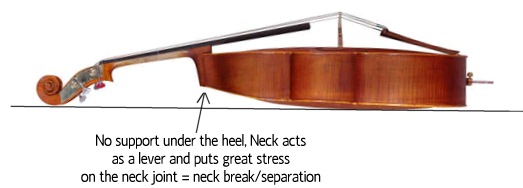Transporting your Double Bass
 As a bassist, sooner or later you realize that your choice of instrument will also dictate your choices in other matters. Vehicles, for instance -- you can pretty much write off getting that Smart Car if you plan on ever taking your bass out. And bicycles are right out, unless you're particularly brave, like that guy over there to the right.
As a bassist, sooner or later you realize that your choice of instrument will also dictate your choices in other matters. Vehicles, for instance -- you can pretty much write off getting that Smart Car if you plan on ever taking your bass out. And bicycles are right out, unless you're particularly brave, like that guy over there to the right.But in all seriousness, whatever you drive (or ride) there are a few tips for ensuring a smooth, smart move with your bass from home to gig (or rehearsal, or lesson) and back again. Here are a couple tips, and some "dos and don'ts."
Gig Bags...
Soft carry bags come in a lot of different qualities and weights. For example, our "standard" gig bag, which has adequate padding for most peoples' use. If you're taking the bass out of the house a couple of times a week, you might consider spending a little extra on your bag; aside from offering more protection against more frequent bumps/knocks/bouncing around in the van, it will also be subject to more wear and tear. Though with more padding and heavier-duty hardware comes more weight, too - so factor that in as part of your decision. But for once or twice a month "weekend warriors," a standard weight gig bag will suffice.- DO: Read up on the instructions that come with your bag (at least when you buy them from us, anyway). Certain handles are designed for certain uses, such as carrying the entire weight vs. moving it around in your vehicle. Yanking on them contrary to their design can sometimes cause them to be damaged. We are talking about fabric and stitching here, there are limitations! And using things in ways for which they weren't designed will usually get you in trouble.
 DON'T: Trust a shoulder strap as if it were a backpack strap. Many bags include "D-rings" to add a shoulder strap. Proper use is to put it over one shoulder, and use your arm to steady/help carry. In today's world, many D-rings are only bent into shape ( ends not welded), and might not fully deserve your trust to not suddenly "let go," as they're not designed for the higher stress of being carried as the bassist in the photo to the right is doing. If you want to carry it like this, some bags (like our pro bag) have real backpack straps built in, you can usually be confident that they are up to the task.
DON'T: Trust a shoulder strap as if it were a backpack strap. Many bags include "D-rings" to add a shoulder strap. Proper use is to put it over one shoulder, and use your arm to steady/help carry. In today's world, many D-rings are only bent into shape ( ends not welded), and might not fully deserve your trust to not suddenly "let go," as they're not designed for the higher stress of being carried as the bassist in the photo to the right is doing. If you want to carry it like this, some bags (like our pro bag) have real backpack straps built in, you can usually be confident that they are up to the task.
Bonus TIP: Bob got this advice when he bought a two instrument electric bass bag of a certain make over a dozen years ago: If you are uncomfortable with open or weak D rings, replace them with solid round split key rings.- DO: periodically inspect your bag's integrity. Check for seam rips, examine strap and handle connection points, zipper stitching and condition. The old saying, "a stitch in time saves nine" is soooo true! Don't be embarrased, hit a store for a heavy duty needle and thread and take a shot at it, it doesn't have to be pretty, just effective. (Bob: I once had an old Kay case that was more iron-on patches than material when I retired it!)
One of our customers, Dennis, adds: Regarding stitch-in-time....... just a suggestion..... for years I have had guitar and electric bass gig bags repaired (seams and zippers) and amp covers repaired at very low cost and usually while I waited at the local COBBLER SHOP. They can re-stitch seams and straps and handles and torn stitching at the zippers in minutes.
Vehicles...
When packing up for a gig, the bass has its unique issues. It's large, cumbersome, and fragile. The bridge could be knocked out of position if something falls against it, causing anything from a minor annoyance to a major catastrophe. I recommend putting the bass on its side, with its back against a wall of the vehicle (minivan, SUV, whatever you've got) and either bungee-corded to some hold-down points, or braced with large, relatively immovable objects to keep it from rolling over when taking corners too fast. Certain cars make that difficult (I wish I had video of the process it took to get my bass into my 2001 VW Jetta - but it could be done!) but this is the ideal.- DO: Secure other items to prevent them from shifting and striking your bass (amps, folding chairs, other gear, etc.)
- DON'T: DON'T EVER lay your bass on its back without support. The scroll extends beyond the back of most any bass, and laying the bass on its back creates a "triangle" of sorts (see below). This puts a LOT of strain on the neck heel joint, which already is holding steady against the string tension. It certainly doesn't need any more stress (who does?) so don't do it! If you must lay it flat due to space or other considerations, put something (folded movers' blankets? Firm pillows?) underneath its shoulders to lift the pegbox up off the floor and prevent that damage. Same goes for those of us with sedans; having a point below the center of the body and the neck (on the seat backs, for instance) be the only support for your bass means you are yanking that neck joint into failure!

Final, related, non-case carry tips: Never carry your bass by the end of the fingerboard, the f-holes, or the neck. Yeah, I know there are guys who stand on their basses... we're not going there!
